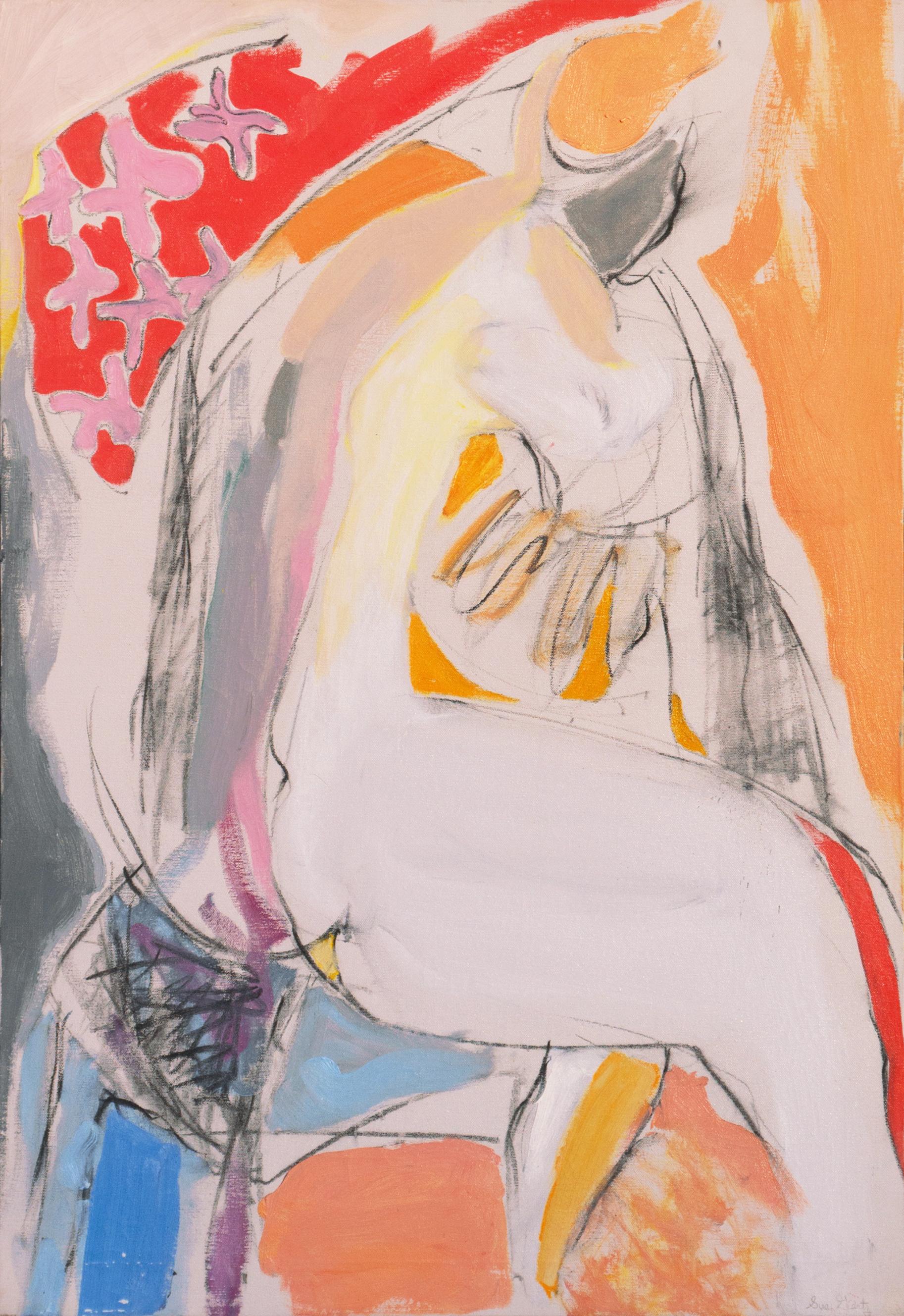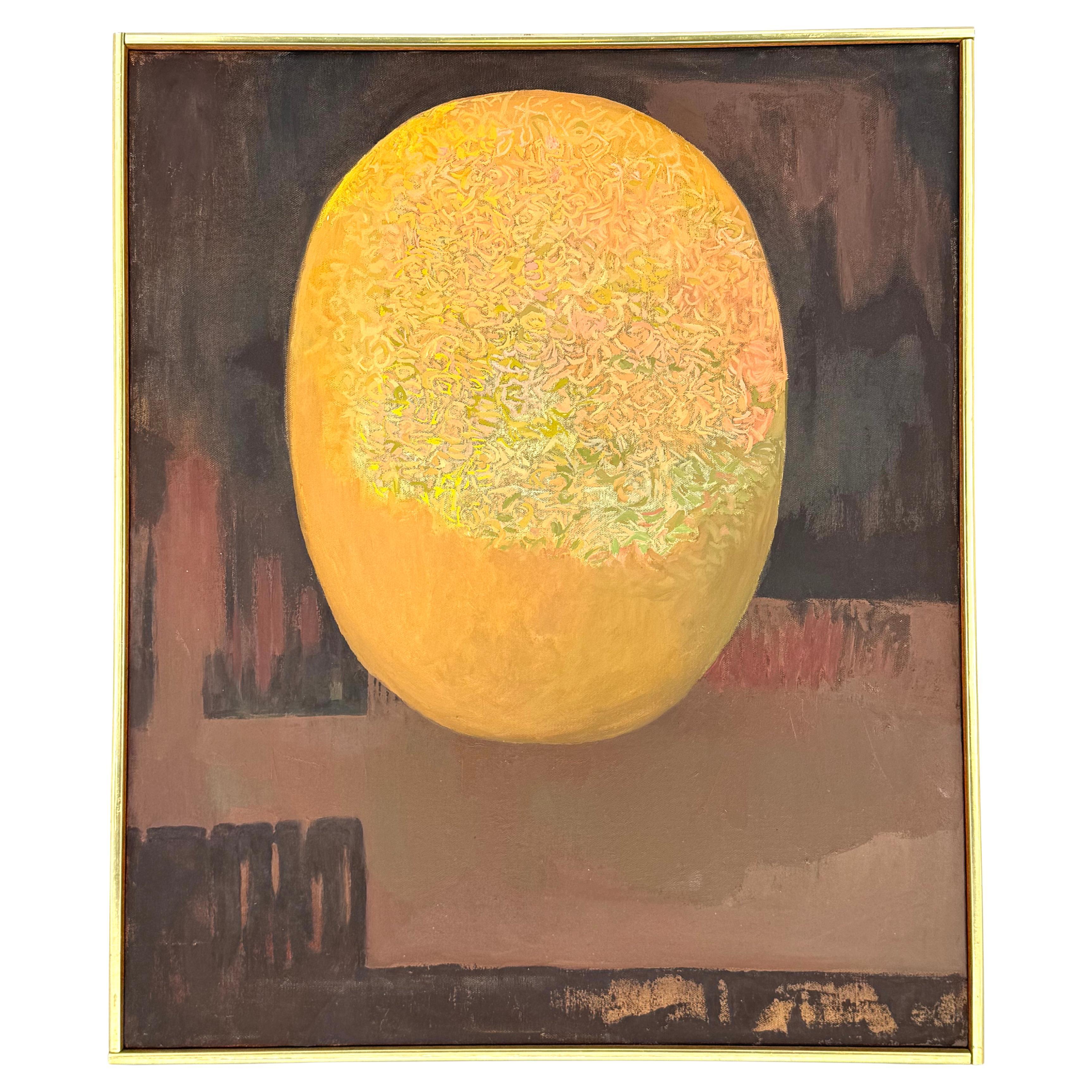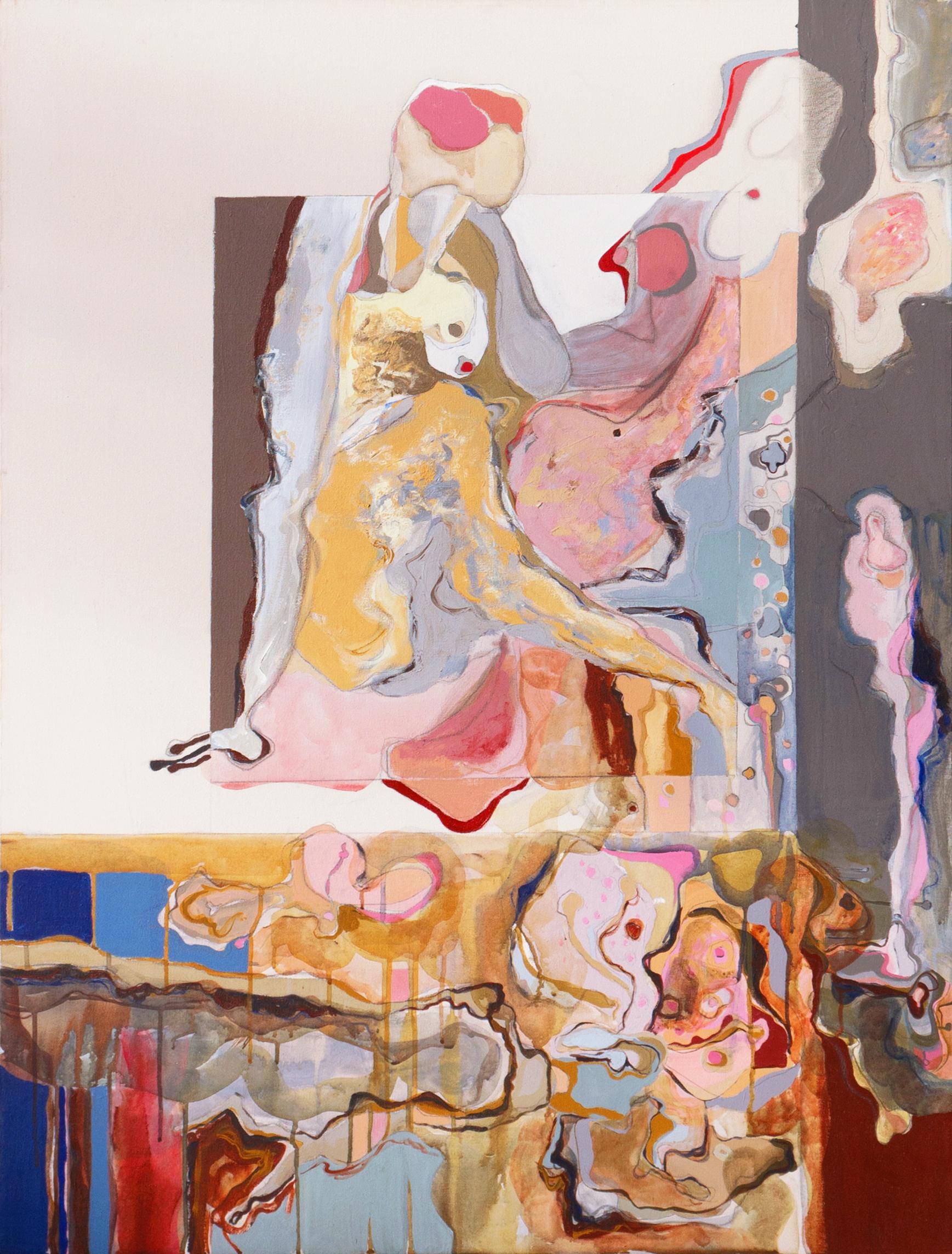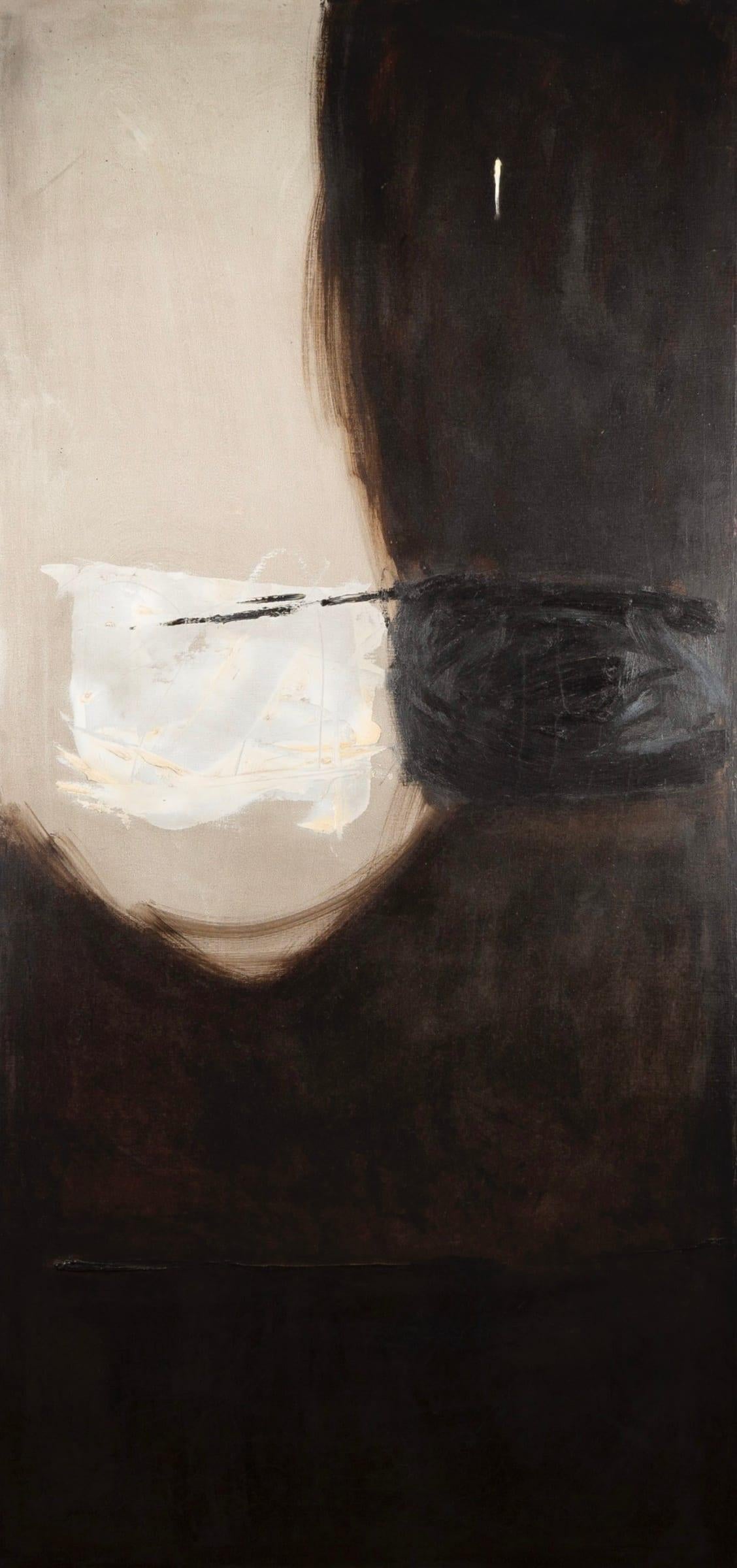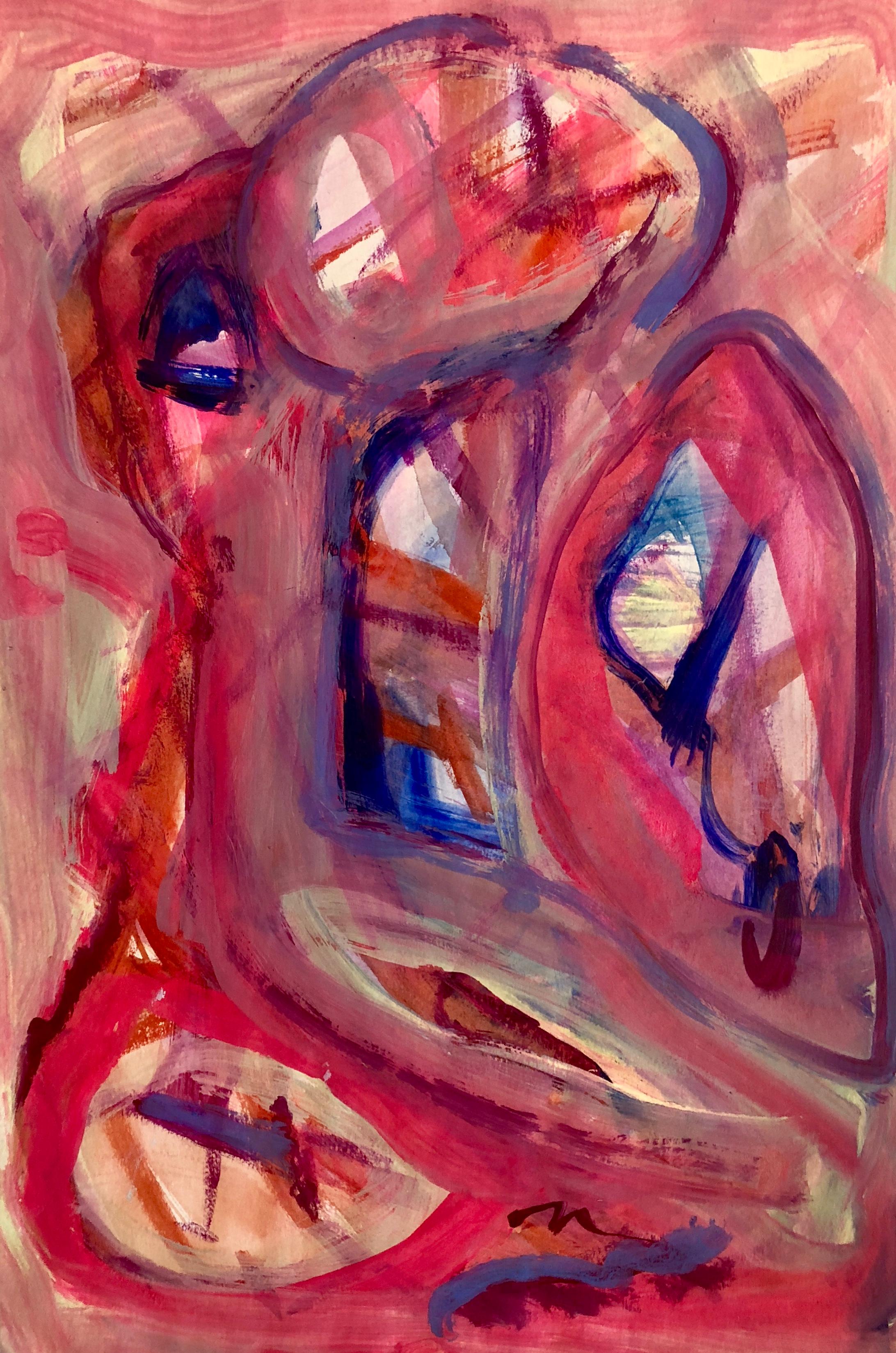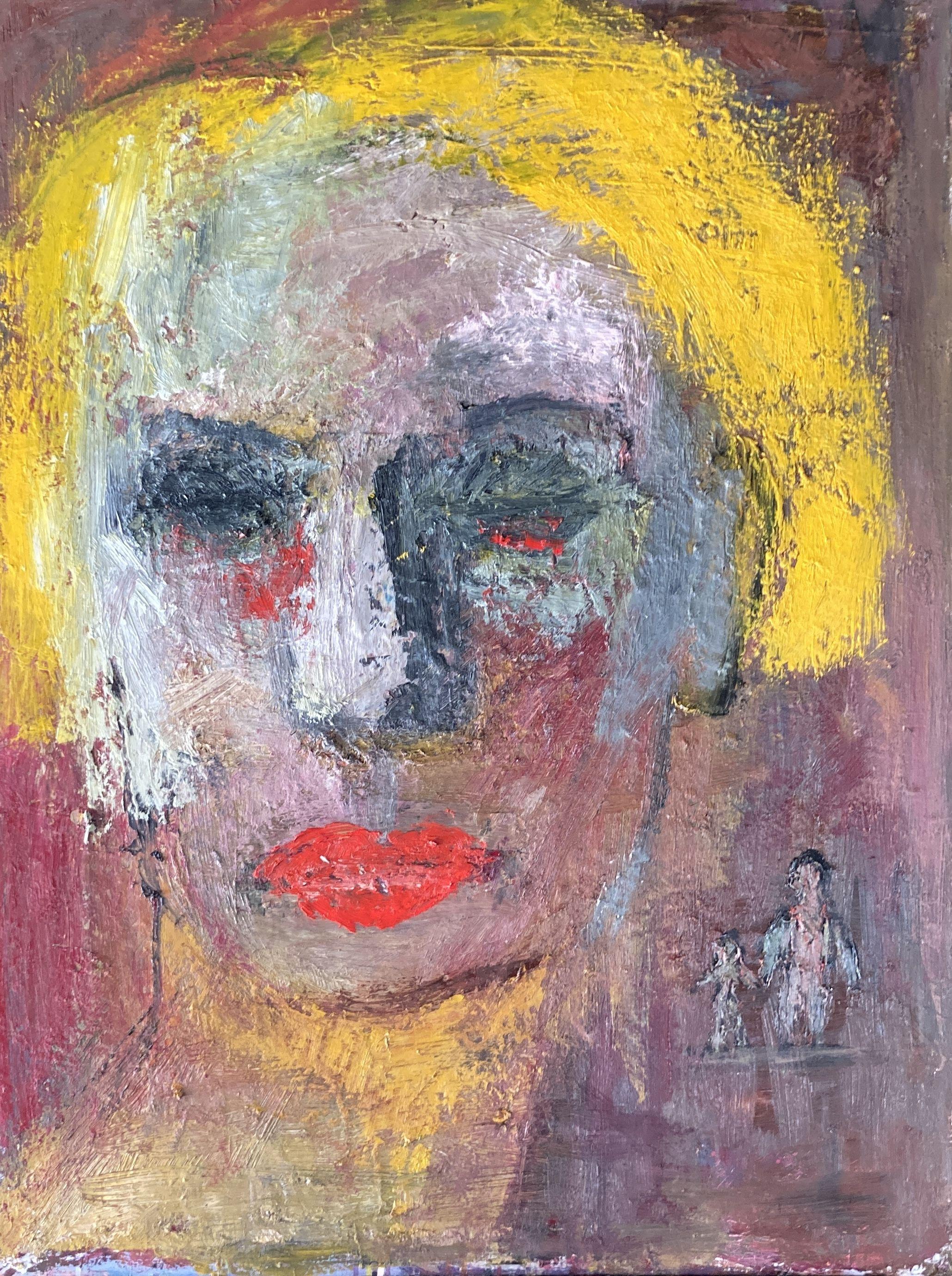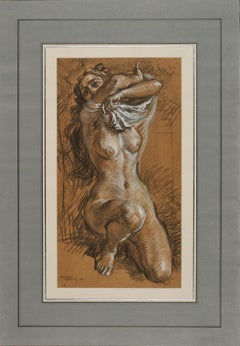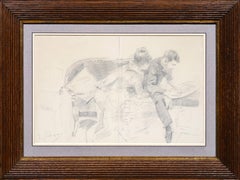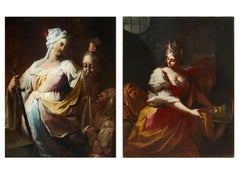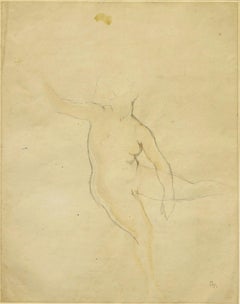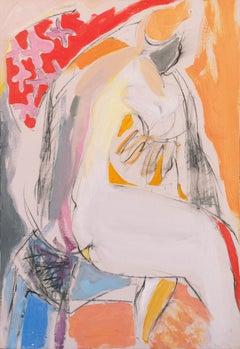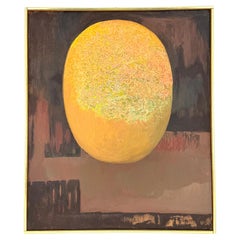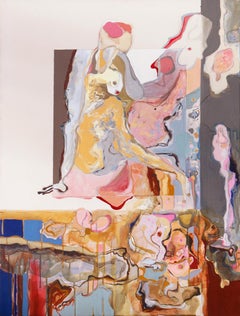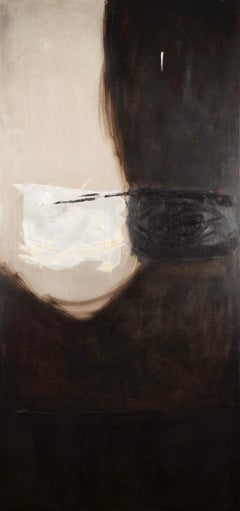Items Similar to Infanta - Study Number 6, a 1960 painting by Fermin Aguayo after Velázquez
Want more images or videos?
Request additional images or videos from the seller
1 of 12
Fermin AguayoInfanta - Study Number 6, a 1960 painting by Fermin Aguayo after Velázquez
$10,406.33
£7,910.55
€8,800
CA$14,624.53
A$15,902.10
CHF 8,378.85
MX$193,164.36
NOK 105,339.11
SEK 98,746.91
DKK 67,357.05
About the Item
Initialled and dated lower right "a/60", countersigned and dated on the back "aguayo 60".
A breath of modernity animates this iconic work, inspired by Velázquez' portrait of the Infanta Margarita, which reveals the immense talent of the painter Fermin Aguayo, then in exile in Paris.
1. Fermin Aguayo, a Spanish painter in Paris
Fermín Aguayo is one of the most remarkable Spanish painters of the second half of the 20th century. Born in 1926 in Sotillo, a small village in Castile, Fermin Aguayo had a difficult childhood, marked by the war. After his father and two brothers were shot in 1936 by the Francoists, he lived a wandering existence with his mother before settling in Zaragoza in 1938.
A self-taught painter, he began to paint around 1941, first in gouache and watercolour before tackling oil around 1945. In 1947, he was one of the founding members of the Portico group with six other painters, which claimed abstraction as its mode of expression, but the adventure was short-lived.
In 1952, he moved to Paris, fleeing the stifling artistic atmosphere of Zaragoza. This marked the beginning of a much harsher adventure, as he resumed his pictorial research alone, with the support of the Jeanne-Bucher gallery, his wife Marguerite Legrand (whom he met in Paris) and a few friends: this was the period of his abstract compositions, fragmented with knives, in plunging and centered perspectives, in the muted tones of the arid lands of Castile. Aguayo’s painting took on a new fluidity, a transparency that hinted at a vibrant interiority.
In 1960, he abandoned abstraction and returned to figuration. He turned to the great masters of painting through the centuries (Velazquez, Rembrandt, Titian, Tintoretto, Ribera, Goya, Manet and Van Gogh), to whom he resembled in his transition from abstract painter to painter of reality, in the sense of a deeply felt presence, a transformation of matter into something alive, as he himself would say.
He died suddenly of cancer in Paris on 22 November 1977. The artist is now part of the collections of the Museo Reina Sofia, the Museo Patio Herreriano, the Musée Fabre (Montpellier), the Musée Cantini (Marseille), the Musée des Beaux-Arts de Dijon, the CNAP, the Fondation Planque, etc…The Reina Sofia Museum in Madrid held an important retrospective of his work in 2005.
2. The Infanta Margarita, from Velázquez to the fascination of moderns
Our painting is a very personal interpretation, using shades of pink, brown and grey, of the portrait of the Infanta Margarita, one of Velázquez (1599 - 1660) masterpieces kept in the Prado Museum (5th picture in the Gallery). The First daughter of King Philip IV with his second wife, Marie-Anne of Austria, the Infanta married Emperor Leopold 1st and died at the age of 21. She is also the figure in the middle of Velázquez' most famous painting, the Meninas.
In 1957, Picasso tackled this icon of Spanish painting to radically renew the way we look at it. A 1957 painting in the Museu Picasso in Barcelona bears witness to this research (last picture in the Gallery).
Three years later, when Fermin Aguayo took his turn to tackle Velasquez, he was at a decisive turning point in his career, moving away from Cubism and returning to figuration. It is interesting to note that the artist has profoundly altered the dimensions of Velázquez' work, focusing in on the figure of the Infanta, without all the space that overhangs her in the Prado portrait. The Infanta is depicted in a simulated frame whose colours are in harmony with those of the painting. As this frame is included in the canvas, we have kept the original presentation in which the canvas is simply inserted into a discreet light-coloured oak strip.
We find the same composition in another study of the same series Infanta - Study number 2 which sold for €17,000 (Hammer price) in Paris in 2006 (7th picture in the Gallery).
Aguayo synthesises the main decorative elements (skirt motifs, ear knot) into a harmonious composition that makes the Infanta immediately recognisable. The stripes on the skirt in this painting form an astonishing fishbone pattern of great decorative force. It seems that these studies constitute a step towards the larger formats also presented at the Galerie Jeanne Bucher in October 1961 (6th photo in the Gallery).
After Picasso and Aguayo, this fascination with Velasquez' work continued throughout modern Spanish art. For example, Salvador Dali's Pearl painted in 1981 (in which he plays on the etymology of the name Margarita) , or more recently the research of Manolo Valdés .
- Creator:Fermin Aguayo (1926 - 1977, Spanish)
- Dimensions:Height: 25.63 in (65.11 cm)Width: 19.75 in (50.17 cm)
- Medium:
- Movement & Style:
- Period:
- Condition:25 5/8” x 19 ¾” (65 x 50 cm) - 26” x 20 ¼’’ (66 x 51.5 cm with frame) Provenance: Galerie Jeanne Bucher, Paris - "Aguayo" exhibition, October 1961, number 21; Hélène Bokanowski Collection.
- Gallery Location:PARIS, FR
- Reference Number:1stDibs: LU1568216355482
About the Seller
5.0
Vetted Professional Seller
Every seller passes strict standards for authenticity and reliability
Established in 2020
1stDibs seller since 2021
10 sales on 1stDibs
- ShippingRetrieving quote...Shipping from: PARIS, France
- Return Policy
Authenticity Guarantee
In the unlikely event there’s an issue with an item’s authenticity, contact us within 1 year for a full refund. DetailsMoney-Back Guarantee
If your item is not as described, is damaged in transit, or does not arrive, contact us within 7 days for a full refund. Details24-Hour Cancellation
You have a 24-hour grace period in which to reconsider your purchase, with no questions asked.Vetted Professional Sellers
Our world-class sellers must adhere to strict standards for service and quality, maintaining the integrity of our listings.Price-Match Guarantee
If you find that a seller listed the same item for a lower price elsewhere, we’ll match it.Trusted Global Delivery
Our best-in-class carrier network provides specialized shipping options worldwide, including custom delivery.More From This Seller
View AllStudy for the Spring (preparatory to the Four Seasons) by René-Marie Castaing
Located in PARIS, FR
René-Paris Castaing, winner of the Grand Prix de Rome in 1924, left a large body of work, both sacred and secular. Many churches in the Pyrénées-Atlantiques, in South-West France still bear witness to the diversity of his talent. In 1942, he began a major decoration project for the Château de Diusse, in the north-east of the county, including an allegory of the four seasons. The vigorous pastel we are presenting here is a study for Spring, depicted as Flore undressing. This commission was a veritable swan song for the artist, who died a year later at the age of 47.
1. René-Marie Castaing, the great inter-war painter in Pau
René-Marie Castaing was born in Pau on December 16th 1896. His father, Joseph Castaing, was also a painter: he was the official portraitist of Pau's high society, which was particularly cosmopolitan at the end of the century, when many rich foreigners spent the winter in Pau, taking advantage of the mild weather to enjoy an outdoor lifestyle punctuated by hunting, horse ridings and golf.
René-Marie Castaing was admitted to the Ecole Nationale Supérieure des Beaux-Arts in Paris in April 1920 and entered the studio of Paul-Albert Laurens (1870-1934). In 1924, he was awarded the First Grand Prix de Rome for Painting, which earned him a stay at the Villa Médicis for more than three years. He then returned to Pau in 1928, where he lived until his death.
Castaing's work is marked by the academic tradition, in which drawing plays as important a role as painting. Although his drawings are often sketches that help to set up large painted compositions, they stand as independent artworks in which the artist fully expresses the vivacity of his talent.
Castaing was a fervent Christian and religious painting played an essential part in his work, as shown by the decorations he created for the churches of Bizanos, Borce, Bidache and Salies-de-Béarn. The painter also created several secular decorations, such as that for the dining room of the Villa Saint-Basil's in Pau in 1935, and the Hunting at the Albret’s time commissioned in 1940 by the Prefecture of Pau. The décor created in 1942-1943 for the Château de Diusse, a mansion located north-east of Pau, was his last large-scale décor, as the painter died shortly after its completion on December 8th 1943.
2. Description of the drawing
Our pastel depicts an eminently secular theme: Spring is embodied by Flore, crouching on the ground with one knee touching the ground. She reveals her ample bosom by removing her shirt, her arms raised above her shoulders to undress.
Given Castaing's classical training at the Beaux-Arts and the influence of ancient statuary...
Category
1940s Art Deco Nude Drawings and Watercolors
Materials
Pastel
Portrait of Paul-César Helleu, a drawing by Rafael de Ochoa y Madrazo (ca. 1885)
Located in PARIS, FR
This lively drawing immerses us in the artistic world of Paris at the end of the 19th century. After meeting the painter Helleu in 1881, Rafael de Ochoa y Madrazo, a young Spanish pa...
Category
1880s Impressionist Portrait Drawings and Watercolors
Materials
Paper, Graphite
Judith and Salome, a pair of oil paintings on canvas by Francesco Conti
Located in PARIS, FR
This widely referenced pair of paintings is one of Francesco Conti’s most successful productions. Francesco Conti is one of the finest painters of 18th-century Florence. In the shimmering colors typical of his best work, he represents two opposite characters from the Bible: the virtuous Judith, whose courage saves her people by cutting off the head of the invader Holofernes, and the depraved Salome, who under the influence of her mother becomes responsible for the beheading of the prophet John the Baptist.
The artist's talent lies in his ability to treat these two macabre subjects with a light touch, presenting us with two attractive women who seem to twirl with glee amidst the severed heads...
1. Francesco Conti, the “Florentine Tiepolo”
Francesco Conti is a major painter of the Florentine school of the 18th century; he can even probably be considered, along with Giovanni Domenico Ferretti (1692-1768), as one of the two main painters of the second quarter of the Florentine 18th century.
Born in Florence in 1682, Francesco Conti began his apprenticeship in the workshop of Simone Pignoni (1611 - 1698), a disciple of Francesco Furini; he was also influenced by the Venetian Sebastiano Ricci. A protégé of Marquis Riccardi, he accompanied him to Rome between 1699 and 1705, where he frequented Carlo Maratta's studio. He settled permanently in Florence in 1705.
Painted exclusively on canvas, the majority of his work consists of religious subjects, altarpieces or private devotional works. It is likely that Conti himself was a devout churchgoer, as evidenced by his affiliation, in the third decade of the eighteenth century, to the Society of the Disciples of Saint-John-the-Baptist, and his entry, at the end of his life, into the fraternity of the Venerable Society of the Holy Trinity.
In Florence, Conti worked for the Grand Duchy's major patrons, including the last Medici - in particular Giangastone and Annamaria Luisa, Electress Palatine - and confirmed his role as a reference painter under the Lorraine Regency, as master of the Public Drawing School, which was closely linked to the institute responsible for the manufacture of semi-precious stone mosaics, then located in the Uffizi complex.
Matteo Marangoni, an art critic of the early 20th century, praised his "brushwork full of elegance and true spirit of the 18th century", pointing out that Conti was "probably one of the best colorists" of the Florentine school of his time. These two characteristics led the art historian Paolo dal Poggetto to nickname him the "Florentine Tiepolo".
2. Judith and Salome, two biblical characters opposing each other
These two paintings form a pair presenting two biblical episodes, which have in common the depiction of a "heroine" carrying the severed head of a man.
While the Salome episode might at first appear to be an echo of the Old Testament story of Judith, each character is the exact opposite of the other. Judith, whose story is told in the Book of Judith, is a beautiful young widow from Bethulia who, accompanied by her maid, went into the camp of the invading Assyrians and won the confidence of Holofernes, the general commanding the enemy army. Invited to a great feast on the fourth evening, she took advantage of Holofernes' drunkenness to cut off his head. “She went up to the bedpost near Holofernes’ head, and took down his sword that hung there. She came close to his bed, took hold of the hair of his head, and said, “Give me strength today, O Lord God of Israel!” Then she struck his neck twice with all her might, and cut off his head. Next she rolled his body off the bed and pulled down the canopy from the posts. Soon afterward she went out and gave Holofernes’ head to her maid, who placed it in her food bag...
Category
1710s Old Masters Figurative Drawings and Watercolors
Materials
Canvas, Oil
Study for "Getting up" – 1955, a preparatory drawing by Balthus (1908 -2001)
By Balthus (Balthasar Klossowski de Rola)
Located in PARIS, FR
In 1955, as he was residing at the Château de Chassy in the Morvan for two years, Balthus created a large painting entitled "Getting up". Balthus was inspired for this painting by t...
Category
1950s Modern Nude Drawings and Watercolors
Materials
Watercolor, Pencil
Studies for the Judgment of Solomon, a double-sided drawing by Simone Cantarini
Located in PARIS, FR
In this double-sided red chalk study, Simone Cantarini offers us a double reflection on the theme of the Judgment of Solomon. This sheet reveals his precise style and his sense of de...
Category
1640s Old Masters Figurative Drawings and Watercolors
Materials
Chalk, Laid Paper
Frieze of antique figures, a drawing by the sculptor Antoine-Denis Chaudet
Located in PARIS, FR
Faithful to the neo-classical taste, sculptor Antoine-Denis Chaudet presents us with a frieze of antique figures executed in gray wash over pencil strokes, which is likely inspired b...
Category
Early 1800s Old Masters Figurative Drawings and Watercolors
Materials
Paper, Pencil, Ink
You May Also Like
'Abstract Figural', Woman Artist, Art Institute of Chicago, San Bernardino
Located in Santa Cruz, CA
Signed lower right, in graphite, 'Sue Gertz' for Suzanne Gertz (American, 1938-2003) and painted circa 1975.
Suzanne Gertz first studied at the Art Institute of Chicago and, subsequ...
Category
1970s Modern Nude Paintings
Materials
Oil, Canvas, Charcoal
Ruth Armer (1896-1977) "Painting No. 4" Oil on Canvas, 1966
By Ruth Armer
Located in Sacramento, CA
Abstract oil on canvas by artist Ruth Armer (1896-1977).
Entitled "Painting No. 4", produced in 1966.
Unsigned with labels on verso from San Francisco Museum of Art Rental Gallery ...
Category
Vintage 1960s American Modern Paintings
Materials
Canvas, Paint
'Figurative Abstract', Woman Artist, Art Institute of Chicago, San Bernardino
Located in Santa Cruz, CA
Stamped, verso, with certification of authenticity for Suzanne Gertz (American, 1938-2003) and painted circa 1985, partial signature lower right.
Suzanne Gertz first studied at the...
Category
1980s Modern Nude Paintings
Materials
Canvas, Acrylic, Graphite
Untitled, Oil on Canvas by Douglas Swan, 1963 Circa
By Douglas Litterick Swan
Located in Kingsclere, GB
Untitled, Oil on Canvas by Douglas Swan, 1963 Circa
Additional information:
Medium: Oil on Canvas
60 x 25 1/2 in
152.4 x 64.8 cm
Signed and inscribed ve...
Category
20th Century Abstract Paintings
Materials
Canvas
Untitled Figure (c. 1950s)
By Adine Stix
Located in Summit, NJ
Gorgeous oil and watercolor on paper by abstract expressionist artist Adine Stix. Beautiful shades of pink, purples, cobalt blue with s hint of orange cover the paper to create the h...
Category
1950s Abstract Expressionist Abstract Paintings
Materials
Paper, Oil, Watercolor
Norma, Painting, Oil on Canvas
By Raul Paniagua
Located in Yardley, PA
This painting emerged from layers upon layers of material, It's like building something, then tearing it down, and rebuilding it again until I feel it's right. ...
Category
2010s Abstract Expressionist Paintings
Materials
Oil
More Ways To Browse
Picasso 1957
Valdes Manolo
1981 Pearl
Spanish Jewish
Terry Shelbourne
Tiziano Vecellio
16th Century Religious Painting
1860 Oil Painting Of Woman In Black Dress
Antique Oil Painting Skull
Antique Oil Portrait Child
Bernardino Campi
Consuelo Vanderbilt
David Alison
Dod Procter
Elizabethan Dress
Elizabethan Painting
Erik Olson
Francois De Troy
